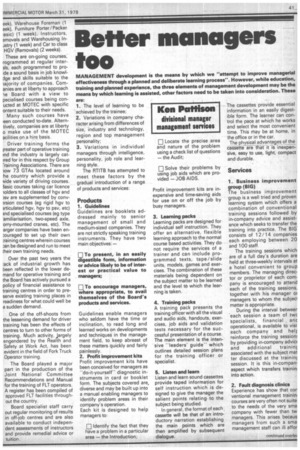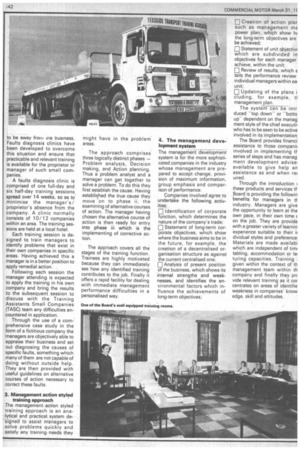Better managers
Page 33

Page 34

If you've noticed an error in this article please click here to report it so we can fix it.
MANAGEMENT development is the means by which we "attempt to improve managerial effectiveness through a planned and deliberate learning process". However, while education, training and planned experience, the three elements of management development may be the means by which learning is assisted, other factors need to be taken into consideration. These are: 1. The level of learning to be achieved by the trainee; 2. Variations in company character arising from differences of size, industry and technology, region and top management personality; 3. Variations in individual managers through intelligence, personality, job role and learning style.
The RTITB has attempted to meet these factors by the gradual introduction of a range of products and services:
Products
1. Guidelines Guidelines are booklets addressed mainly to senior management of small and medium-sized companies. They are not strictly speaking training instruments. They have two main objectives:— Guidelines enable managers who seldom have the time or inclination, to read long and learned works on developments and techniques in the management field, to keep abreast of these matters quickly and fairly painlessly.
2. Profit improvement kits Profit improvement kits have been conceived for managers as -do-it-yourself" diagnostic instruments in card or booklet form. The subjects covered are diverse and may be built up into a manual enabling managers to identify problem areas in their company's operation.
Each kit is designed to help managers to Profit improvement kits are inexpensive and time-saving aids for use on or off the job by busy managers.
3. Learning packs Learning packs are designed for individual self instruction. They offer an alternative, flexible learning approach to the normal course based activities. They do not require the services of a trainer and can include programmed texts, tape/slide units, models, games and exercises. The combination of these materials being dependent on the subject matter to be learned and the level tb which the learning is taken.
4. Training packs A training pack presents the training officer with all the visual and audio aids, handouts, exercises, job aids and validation tests necessary for the successful presentation of a course. The main element is the intensive "leaders' guide" which outlines detailed session plans for the training officer or specialist.
5. Listen and learn Listen and learn sound cassettes provide taped information for self instruction which is designed to give the manager the salient points relating to the subject being studied.
In general, the format of each, cassette will be that of an introductory narration establishing the main points which are then amplified by subsequent dialogue. The cassettes provide essential information in an easily digestible form. The learner can control the pace at which he works and select the most convenient time. This may be at home, in the office or in the car.
The physical advantages of the cassette are t-Fat it is inexpensive, easy to use, light, compact and durable.
Services
1. Business improvement group (BIG) The business improvement group is a well tried and proven learning system which offers a combination of conventional training sessions followed by in-company advice and assistance which seeks to transfer the, training into practice. The BIG consists of 12/14 companies each employing between 20 and 100 staff.
The training sessions which are of a full day's duration are held at three-weekly intervals at a hotel convenient to group members. The managing director or proprietor of each company is encouraged to attend each of the training sessions, together with his manager OT managers to whom the subjed matter is appropriate.
During the interval betweer each session a team of twc specialists, financial anc operational, is available to visi. each company and helr reinforce the training session! by providing in-company advice
and additional trainirm associated with the subject mat ter discussed at the trainirm session. It is this in-comparr aspect which transfers trainin! into action.
2. Fault diagnosis clinics Experience has show that cor ventional management trainin! courses are very often not suite, to the needs of the very sma company with fewer than tw managers. This arises becaus managers from such a sma management staff can ill affor to be away frorn Lne business. Faults diagnosis clinics have been developed to overcome this situation and ensure that practicable and relevant training is available for the proprietor or manager of such small cornpanies.
A faults diagnosis clinic is comprised of one full-day and six half-day training sessions. spread over 14 weeks, so as to minimise the manager's/ proprietor's absence from the company. A clinic normally consists of 10 / 12 companies .within an area. The training sessions are held at a local hotel.
Each training session is designed to train managers to identify problems that exist in their own companies in specific areas. Having achieved this a manager is in a better position to apply remedial action. .
Following each session the manager attending is expected to apply the training in his own company and bring the results to the subsequent session to discuss with the Training Assistants Small Companies (TASC) team any difficulties encountered in application.
Through the use of a comprehensive case study in the form of a fictitious company the managers are objectively able to appraise their business and set out diagnosing the causes of specific faults, something which many of them are not capable of doing without outside help. They are then provided with useful guidelines on alternative courses of action necessary to correct these faults.
3. Management action styled training approach The management action styled training approach is an analytical and practical system designed to assist managers to solve problems quickly and satisfy any training needs they might have in the problem areas.
The approach comprises three logically distinct phases — Problem analysis, Decision making, and Action planning. Thus a problem analyst and a manager can get together to solve a problem. To do this they first establish the cause. Having established the true cause they move on to phase ii, the examining of alternative courses of action. The manager having chosen the alternative course of action is then ready for entry into phase iii which is the implementing of corrective action.
The approach covers all the stages of the training function. Trainees are highly motivated because they can immediately see how any identified training contributes to the job. Finally it offers a rapid facility for dealing with immediate management performance difficulties in a personalised way. 4. The management development system The management development system is for the more sophisticated companies in the industry whose management are prepared to accept change, provision of maximum information, group emphasis and comparison of performance.
Companies involved agree to undertake the following activities
fl Identification of corporate function, which determines the nature of the company's trade; [1 Statement of long-term corporate objectives, which show where the business aims to be in the future, for example, the creation of a decentralised organisation structure as against the current centralised one;
El Analysis of present position of the business, which shows its internal strengths and weaknesses, and identifies the environmental factors which influence the achievements of long-term objectives; • Creation of action plar such as management ma power plan, which show hi the long-term objectives are be achieved; 0 Statement of unit abjectiy( which are subdivided in objectives for each manager achieve, within the unit;
O Review of results, which E tails the performance review individual managers within ea unit;
O Updating of the plans i cluding, for example, tl management plan.
The system can be intr duced -top downor "bolt° updependent on the manag ment style of the chief executil who has to be seen to be active involved in its implementation The Board provides financi assistance to those companii involved in implementing tlseries of steps and has manag ment development advise available to give help an assistance as and when rei uired.
Through the introduction these products and services th Board is providing the followin benefits for managers in ti industry. Managers are give the opportunity to learn at the own pace, in their own time on the job. They are provide with a greater variety of learnin experience suitable to their ii dividual styles and preference: Materials are made availabl which are independent of -rim' tabling, accommodation or lel turing capacities. Training given within the context of th management team within th -company and finally they pH vide relevant training as it cor centrates on areas of identifie weakness in companies' know edge, skill and attitudes,






















































































































